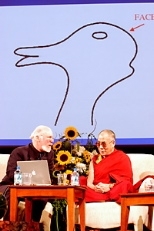The Dalai Lama celebrated the "opportunity to make the conversation between scientists and Buddhists open and accessible to a wider community of people" in opening comments at a news conference at the Charles Hotel on Friday.
"Up to now, science mainly dealt with external things, while the Buddhist tradition is to analyze and investigate our inner world and to transform it. There is potential in working together," the Dalai Lama said.
He spoke alternately in English and Tibetan, relying on an interpreter for longer statements and addressing the Buddhist monks directly in Tibetan to clarify or emphasize certain points.
"I have encouraged and expressed my wish that more students would take an interest in science, and we have recently begun a science curriculum for selected students in scholastic monasteries," he said.
The West is "more advanced in the fields of cosmology, neurobiology, physics and psychology, and Buddhists need to study these fields. Buddhist beliefs can be changed by science. For example, the way ancient texts describe celestial bodies clearly needs to be changed," he said.
The Dalai Lama proposed an "ethics of affection" based on his observations of the bonds between mothers and children.
"I believe affection and appreciation of affection are indispensable to the survival of the child. In modern society, in the modern economic and political system, interdependence is the reality. There is a need for affection for each other. Grownups make the mistake of saying, 'I'm independent.' In reality, affection and compassion are very useful," he said.
The Dalai Lama and the monks who accompanied him wore identical flowing garments composed of brick-red outer layers over a saffron base. The Dalai Lama and several of the monks wore wristwatches, beaded bracelets, leather walking shoes and beige socks.
A version of this article appeared in MIT Tech Talk on September 17, 2003.







